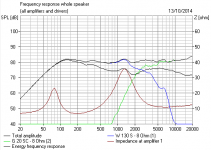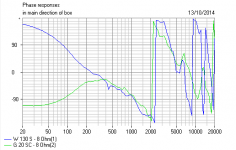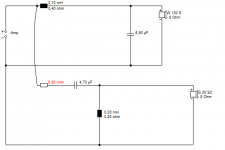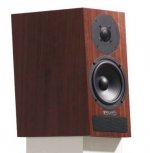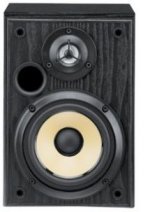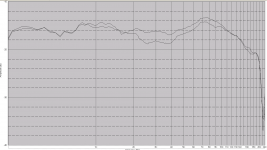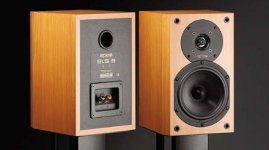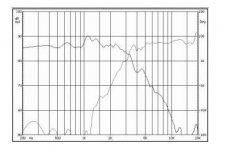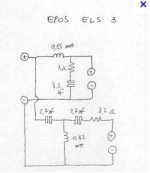Hi,
If you know your stuff you can buy used speakers that
DIY hasn't a hope in hell of competing against bang for
buck, and very often new too, like these :
Wharfedale DIAMOND 9.0 Black | Speakers Per Pair | Richer Sounds
rgds, sreten.
If you know your stuff you can buy used speakers that
DIY hasn't a hope in hell of competing against bang for
buck, and very often new too, like these :
Wharfedale DIAMOND 9.0 Black | Speakers Per Pair | Richer Sounds
rgds, sreten.
Wharfedale Diamond 9.0:
Wharfedale DIAMOND 9.0 Black | Speakers Per Pair | Richer Sounds
Indeed hard to knock the value there. Except it's actually a case of "Honey, I shrunk the speakers!" 😀
Those are a tiny 4-5L volume. So why is this sort of thing the "World's favourite speaker"? It's because 5" bass is actually quite easy to filter with a dome tweeter. The acoustic centres are near enough aligned. It comes out near 3kHz LR2.
I ran a sim with a couple of similar drivers on a narrow 16cm baffle and 7 Litres closed box. You need some hefty baffle step and it's very inefficient. The bump at 1.3kHz is a cone edge resonance that most 5" drivers have. Also the small box really isn't right. Every 5" bass I looked at had a Vas around 15 litres. Which to me says lumpy bass on anything smaller than that.
These sort of speakers are fine in a small kitchen, but stuff like the PMC Twenty.21 at around 12 litres transmission line is nearer the mark IMO. For the technically minded, the PMC uses SEAS 5" paper drivers and SEAS 27mm metal domes crossed over at a lowish 1.8kHz. Little bit of familiar time-alignment there too in the sloped baffle. It's a continuum with a bigger box!
Wharfedale DIAMOND 9.0 Black | Speakers Per Pair | Richer Sounds
Indeed hard to knock the value there. Except it's actually a case of "Honey, I shrunk the speakers!" 😀
Those are a tiny 4-5L volume. So why is this sort of thing the "World's favourite speaker"? It's because 5" bass is actually quite easy to filter with a dome tweeter. The acoustic centres are near enough aligned. It comes out near 3kHz LR2.
I ran a sim with a couple of similar drivers on a narrow 16cm baffle and 7 Litres closed box. You need some hefty baffle step and it's very inefficient. The bump at 1.3kHz is a cone edge resonance that most 5" drivers have. Also the small box really isn't right. Every 5" bass I looked at had a Vas around 15 litres. Which to me says lumpy bass on anything smaller than that.
These sort of speakers are fine in a small kitchen, but stuff like the PMC Twenty.21 at around 12 litres transmission line is nearer the mark IMO. For the technically minded, the PMC uses SEAS 5" paper drivers and SEAS 27mm metal domes crossed over at a lowish 1.8kHz. Little bit of familiar time-alignment there too in the sloped baffle. It's a continuum with a bigger box!
Attachments
At what price point are the best DIY speakers better than the best commercial speakers?
One of the inefficiencies of diy in such comparisons, I believe, is the difference in the paths taken. A manufacturer would aim at beating some benchmark or retaining some specific sound signature with the minimum/cheapest parts that allow it. Goal is to deliver more, but rarely - the maximum of the specific design. A DIY-er would try to come close to the maximum possible, often doing rudiculous choices, such as golden capacitors, EUR30 binding posts and silver wire while using drive units that barely deserve such exotics ( or could expose their qualities ). Heavy braced enclosures and thick walls are also often employed, where a manufacturer would usually avoid this due to shipping costs involved.
The higher the tier of the sound expected, the more the value in the DIY - a commercial speaker that, for example, uses Seas Excel units would rarely cost under 5-6 grand where we all know what`s the instrinsic value of the components and plans of successfull projects are widely available. This is where an extra 20 bucks for thicker wood or golden foil caps don`t add any significant relative (percentagewise) increase in costs. For a speaker that has to fit in a GBP130 upper limit, even 5 bucks may be too much, especially if you intend to motivate your dealers appropriately (otherwise they won`t sell your product, they make a living of this business, at the end).
Look at something like the Sony SSMB-100H. I have a pair of these I bought for $40. I spent $3 on polyester caps to replace the electrolytics and added some free foam. They sound a fair amount better, but not "great". I could never make a speaker of any quality for less than I paid for these. Just making the cabinets would take a few hours and $50 worth of plywood plus parts....
So at the really cheap end you can't beat commercial. For anything over a few hundred bucks, DIY can start to compete, as long as you are willing to spend the time learning about speakers, which isn't exactly cheap.
Unless woodworking and learning about design and making multiple pairs of speakers is something you enjoy, you will probably always be better off buying something premade.
So at the really cheap end you can't beat commercial. For anything over a few hundred bucks, DIY can start to compete, as long as you are willing to spend the time learning about speakers, which isn't exactly cheap.
Unless woodworking and learning about design and making multiple pairs of speakers is something you enjoy, you will probably always be better off buying something premade.
have to second that.
knowledge is power, even in hi-fi.
not "that" hard to find some extreemly cheap priced stuff that can compete well with commerical/used units.
knowledge is power, even in hi-fi.
not "that" hard to find some extreemly cheap priced stuff that can compete well with commerical/used units.
I bought a pair of surplus tweeters for ~$7each and 4 surplus woofers for $9 each. With crossover parts, cabinet, shipping and sundry I would say I spent about $200 for the pair. The gear I measured them with cost another $100, and I'm not counting the time and education it took to design them. They sound great, but need a subwoofer. You might be able to get better for ~$300/pr....but probably not at a big box store.
Ooh, my inner geek is talking to me...😱Look at something like the Sony SSMB-100H. I have a pair of these I bought for $40. I spent $3 on polyester caps to replace the electrolytics and added some free foam. They sound a fair amount better, but not "great". I could never make a speaker of any quality for less than I paid for these. Just making the cabinets would take a few hours and $50 worth of plywood plus parts....
So at the really cheap end you can't beat commercial. For anything over a few hundred bucks, DIY can start to compete, as long as you are willing to spend the time learning about speakers, which isn't exactly cheap.
Unless woodworking and learning about design and making multiple pairs of speakers is something you enjoy, you will probably always be better off buying something premade.
It's saying you could do something with those. 5" polycone and that nice little Sony mylar cone tweeter in 5L reflex. 😀
Just a stupid single capacitor on the tweeter, I expect. This is commercial, after all...😛
Attachments
Hi,
On the other side of the pond The Pioneer AV speakers
designed by Andrew Jones have been making big waves.
They are not great, but they are great value, with proper x/o's,
its generally the lack of proper x/o's that do in cheap speakers.
Pioneer (UK) couldn't be more different to Pioneer (USA).
rgds, sreten.
On the other side of the pond The Pioneer AV speakers
designed by Andrew Jones have been making big waves.
They are not great, but they are great value, with proper x/o's,
its generally the lack of proper x/o's that do in cheap speakers.
Pioneer (UK) couldn't be more different to Pioneer (USA).
rgds, sreten.
Last edited:
DIY speakers don't have to cost a lot or use fancy cabinets to sound good. Here is the Nautaloss spiral sealed TL made using foam core and a pair of $12ea Vifa TC9FD's.
Here is response with a miniDSP as a neutral passthru (no EQ or filters applied to check if it affects response - it doesn't).
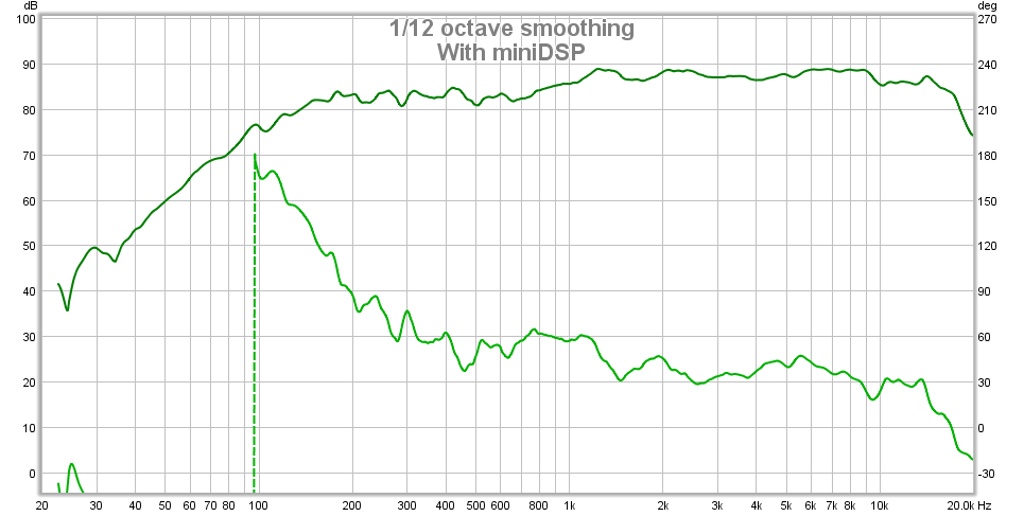
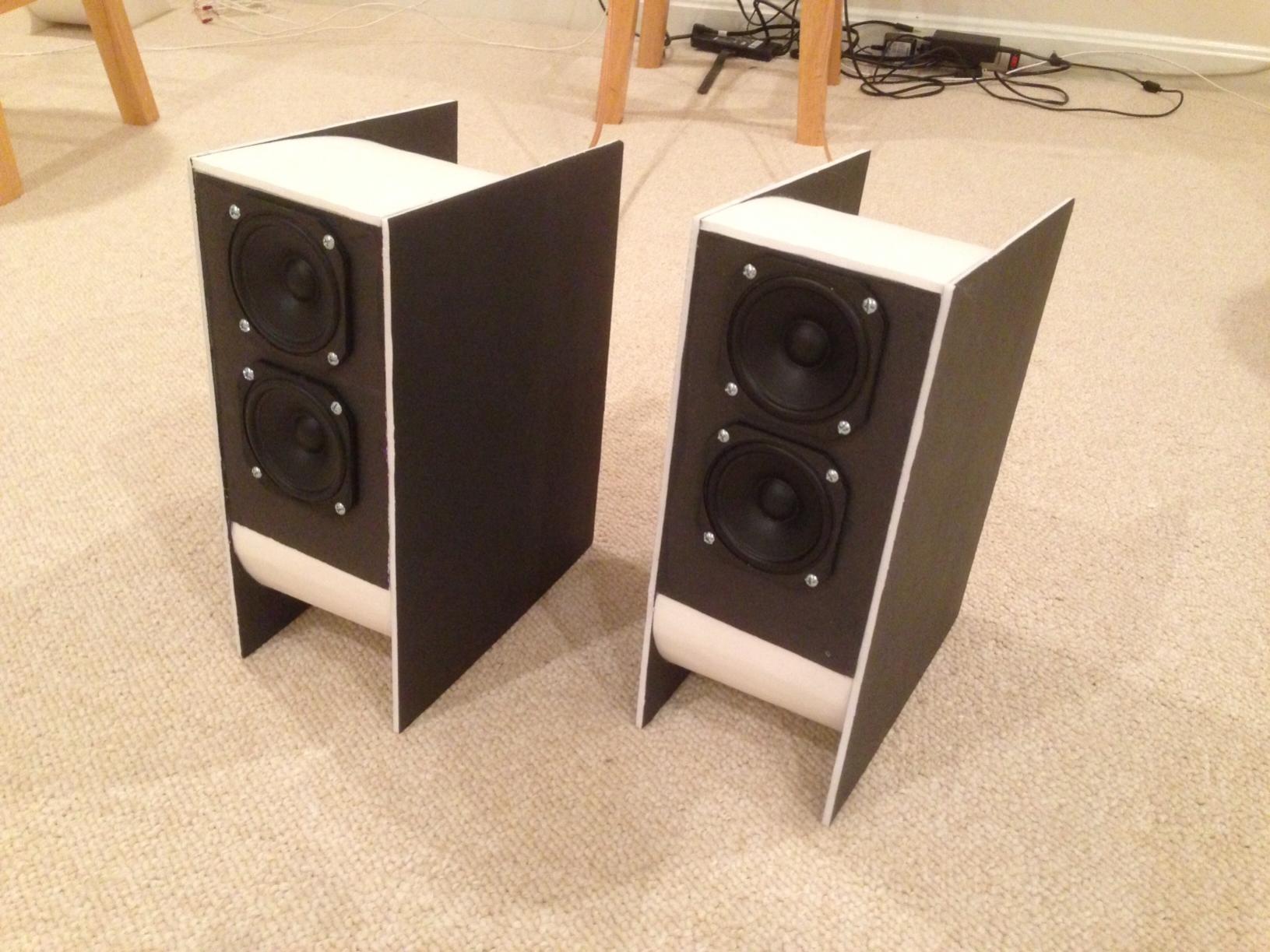
Here is response with a miniDSP as a neutral passthru (no EQ or filters applied to check if it affects response - it doesn't).


Last edited:
Ooh, my inner geek is talking to me...😱
It's saying you could do something with those.
They are actually quite flat - this is the response with no cal file on my ECM-8000. The cal file brings down the 6k peak some and brings up 20kHz as well. The one with the dip matched the other after the caps were replaced with polyester. I found these to be the most neutral of the speakers I listened to at Best Buy that day. 😉 Note, the scale is much tighter than xrk's scale, so it looks lumpier.
Attachments
Last edited:
Well, I would hope the frequency response IS reasonably flat. But that has very little to do with a good sounding speaker. A necessary, but not sufficient condition, I think we'd agree. 🙂They are actually quite flat - this is the response with no cal file on my ECM-8000. The cal file brings down the 6k peak some and brings up 20kHz as well. The one with the dip matched the other after the caps were replaced with polyester. I found these to be the most neutral of the speakers I listened to at Best Buy that day. 😉 Note, the scale is much tighter than xrk's scale, so it looks lumpier.
I was more interested in the DC resistance of the drivers and the actual crossover currently fitted. Here's how the Epos ELS-3 does 4 ohm polycone bass. Quite interesting, IMO.
Attachments
I was more interested in the DC resistance of the drivers and the actual crossover currently fitted.
1.5uF cap on tweeter - woofer is crossed over by self inductance 😉
These are not headbanging speakers, they distort with any appreciable bass input, but they surprised people in our audio club, a lot of people were interested in them.
Attachments
Last edited:
Sony seem to have a knack for drivers that work reasonably well on simple crossovers. But this is a cost constraint. I have no doubt they could be improved dramatically up to being something revealing and undistorted.
I'm also quite sure they sound pretty good as they are. Adequacy may be enough. Alas we can't take it further without knowing the impedance of the drivers.
Time I settled down for the 49ers at St. Louis, I think. I'm on the niners. Doing better than the Vikes this year. 🙂
I'm also quite sure they sound pretty good as they are. Adequacy may be enough. Alas we can't take it further without knowing the impedance of the drivers.
Time I settled down for the 49ers at St. Louis, I think. I'm on the niners. Doing better than the Vikes this year. 🙂
DIY speakers don't have to cost a lot or use fancy cabinets to sound good. Here is the Nautaloss spiral sealed TL made using foam core and a pair of $12ea Vifa TC9FD's.
Here is response with a miniDSP as a neutral passthru (no EQ or filters applied to check if it affects response - it doesn't).


Don't you get combing at high frequencies when you put 2 or more full range in parallel, it becomes worse off-axis. I experienced this when I measured my 2*CHR-70 in parallel it becomes worse off-axis.
There is some but it is in vertical direction and not really noticeable if you are sitting still and far back enough. This was one way to get 91dB sensitivity. Now I would just use a Faital Pro 3FE25 and get 91dB and similar smoothness for $19ea. I still like the TC9FD's for their smoothness though and the vocal mid range is up there with some of the best drivers.
There is some but it is in vertical direction and not really noticeable if you are sitting still and far back enough. This was one way to get 91dB sensitivity. Now I would just use a Faital Pro 3FE25 and get 91dB and similar smoothness for $19ea. I still like the TC9FD's for their smoothness though and the vocal mid range is up there with some of the best drivers.
While I don't doubt your observations of midrange qualities from a couple of Vifa 3.5" fullrangers, you are deluding yourself that the bass and top end problems are negligeable.
You may have found a couple of midrange units that might work well in a more satisfying WMMT arrangement.
An externally hosted image should be here but it was not working when we last tested it.
Now, come on. Get real. It's the cold hard laws of physics in the end. 😀
Meant to be used with a sub XO at 175Hz and I can't hear past 16khz so top end is fine for me. But for the price non one should be complaining. Of course its not going to match a good 3 way system, but at moderate SPL it sounds very nice.
It was meant to be a constructive criticism. The high efficiency Wharfedale E70 was an exceptional loudspeaker IMO. It actually had a very simple crossover too.
Second order bass and tweeter and a simple LC on the mid IIRC. Amazing that it worked so well. Bit like this vintage SEAS kit with a better midrange impedance possibly:
SEAS Kit 503
Hard project to recreate, IMO. But I thank you for telling me about those vifa drivers. 🙂
Second order bass and tweeter and a simple LC on the mid IIRC. Amazing that it worked so well. Bit like this vintage SEAS kit with a better midrange impedance possibly:
SEAS Kit 503
Hard project to recreate, IMO. But I thank you for telling me about those vifa drivers. 🙂
- Status
- Not open for further replies.
- Home
- Loudspeakers
- Multi-Way
- Economics of Budget speakers (especially bookshelf models)
